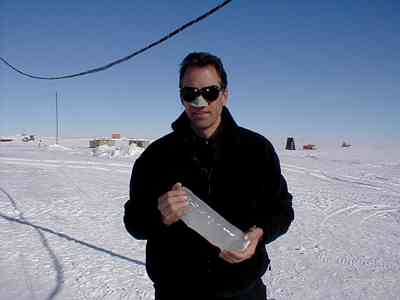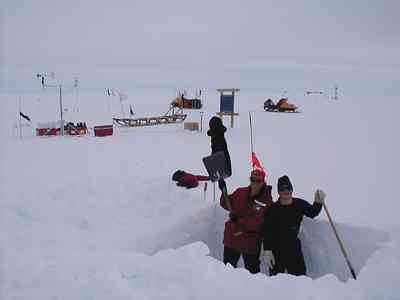2 December, 2000
More Snow and Ice
Sometimes when I look around at the scenery it is easy to forget that, even
though it may look like Kansas in the winter, there is over half a mile of
snow and ice beneath my feet.
I've been here at Siple Dome for ten days. Except for some tiny falling
crystals called diamond dust, it really hasn't snowed during that time. But
when it does snow, it doesn't melt.
The 1000 meters of ice that forms Siple Dome contains an estimated 80,000
to 100,000 years of accumulated snow. Snow that survives a year is called
firn. The firn layer extends down about 70 meters to a level where the air
spaces or pores are no longer connected. Below the firn layer is ice. At
even deeper levels, the pressure increases compressing the air bubbles in
the ice causing them to shrink. At about 1000 meter, near the bottom of the
ice sheet at Siple Dome, the air bubbles disappear into the ice lattice
resulting in clear, blue ice.

I am holding a section of ice core from one of the shallow drill holes. This piece probably came from a depth of about 100 meters (328 feet). It is filled with uniform, tiny bubbles about 2-3mm apart. When put in water, it fizzes as the compressed air in the bubbles is released. This ice formed from snow that fell a few thousand years ago.

Sarah Das and Andy Kurtz from Penn State University seem to be enjoying digging a two-meter snow pit. Sarah is studying how current climate conditions affect snow stratigraphy. Stratigraphy refers to the nature of accumulated snow layers. This information will provide a better understanding of past climates through the study of the stratigraphy in ice cores. On the left is the weather station Sarah established last season. The tower in the right background is an automatic weather station(AWS), one of a network of stations maintained by the University of Wisconsin. It records data every ten minutes which is then sent to an orbiting ARGOS satellite. In the far distance is the main drill site.
Contact the TEA in the field at
.
If you cannot connect through your browser, copy the
TEA's e-mail address in the "To:" line of
your favorite e-mail package.
|
